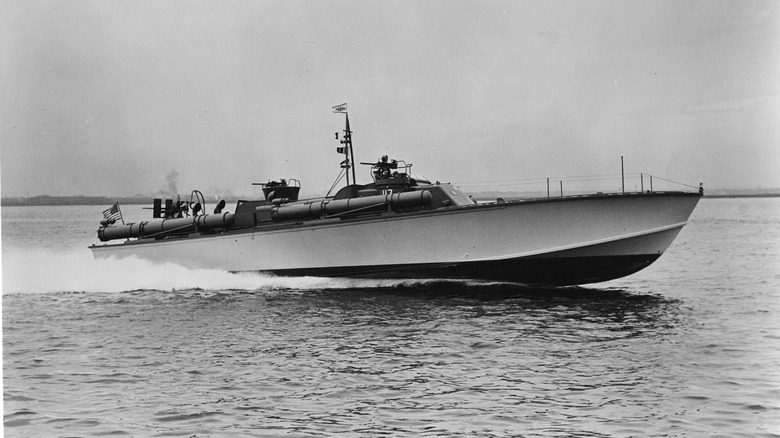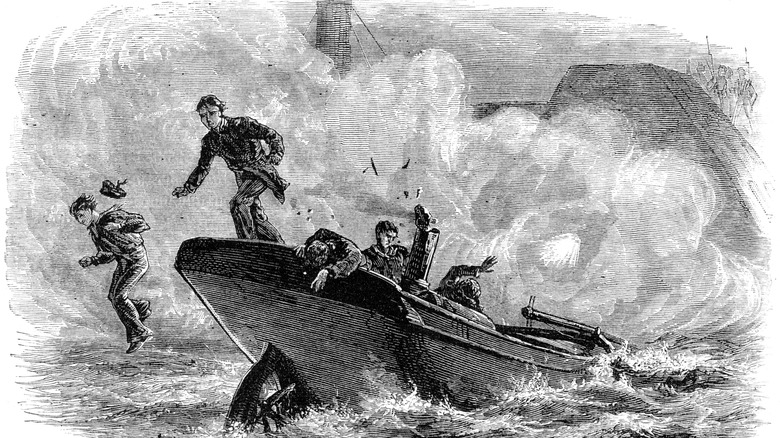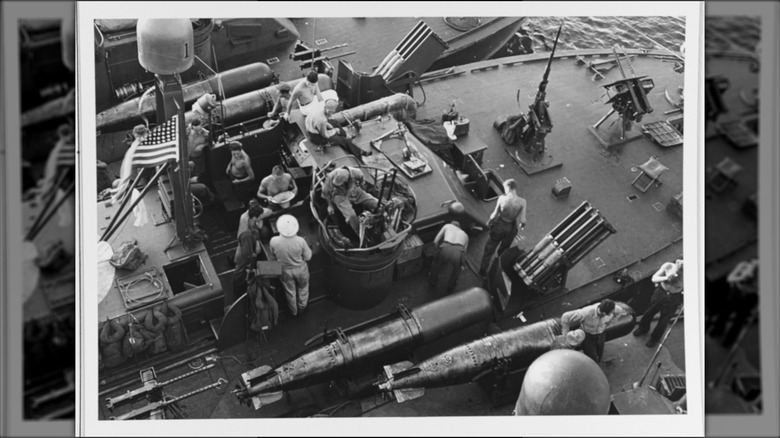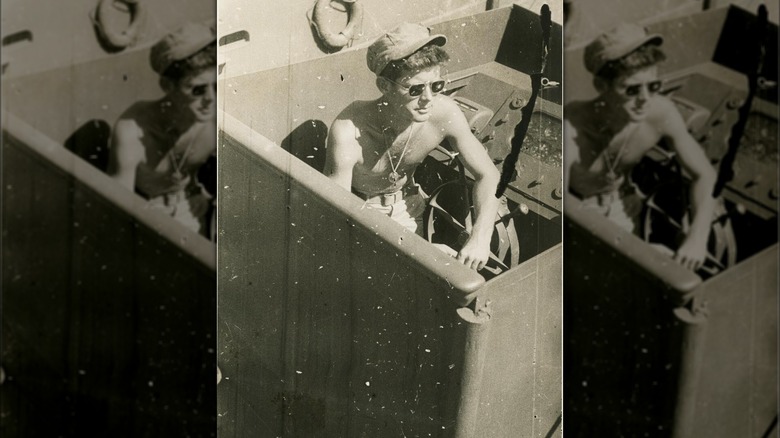Elco PT Boats: A Guide To The Impressive WWII Torpedo Patrols
When you think of Naval vessels, you're likely to conjure up gargantuan aircraft carriers and submarines. Chances are you would never think of a PT boat, and that's if you even know what one is. The only reason a PT boat might sound vaguely familiar is probably due to its association with John F. Kennedy (JFK) and just maybe the movie "PT-109" that was made about his time in the Navy during World War II.
The "PT" stands for Patrol Torpedo (motor torpedo boats or MTBs) and were initially built as annoying anti-ship weapons capable of high-speed torpedo attacks against much larger targets. As the Navy training booklet "Know Your PT Boat" from 1945 characterized them, they were small but mighty at no more than 80 feet long. Granted, they were not as small as the barrier tugboats, the Boomin' Beavers, but then again, those weren't used for attack purposes.
PTs were cheap and easy to build, so they were considered expendable. They were also the "fastest warship afloat" and could dart in and around the shallowest waters at blistering speeds making them ideally suited for scouting missions, disrupting enemy supply lines, dropping mines, laying down smoke screens, rescuing troops, and other activities where a small craft was more advantageous.
[Featured image by National Museum of Health and Medicine via Wikimedia Commons | Cropped and scaled | CC BY-SA 2.0]
Patrol torpedo boats: past and present
While PTs became "famous" between 1941 and 1945, their use stretches back a bit further. In Oct. 1864, while using a small steam launch armed with a torpedo — an early version of the torpedo boat – the Union was able to sink the Confederate ironclad warship (a new type of ship that changed naval warfare forever), Albemarle. Despite the victory, the Navy stopped using it thereafter.
In 1905, a British shipbuilder revitalized the motor torpedo boat (MTB), creating a 15-foot test rig equipped with an Italian Napier steam engine. After, shipbuilders in a litany of other countries — including the United States — started building their own. In 1908, the U.S. Navy proposed using these MTBs for coastal defense but never followed through. Meanwhile, Britain and Italy dove headlong into MTB development. During World War I, they were used with great success as coastal defense boats, and by the end of 1918, as many as 66 were a part of the Royal Navy fleet.
The U.S. Navy dabbled in development throughout the 1920s but never fully committed. It would take until 1937 before the Navy got serious about its own PT boats, and only after then-President Franklin D. Roosevelt provided $15 million to develop one. The Navy asked shipbuilders to submit plans for a 54-foot-long craft as well as a 70-footer.
Float like a butterfly, sting like a bee
Enter Henry R. Sutphen, executive vice president of the Electric Boat Company. He met with Assistant Secretary of the Navy Charles Edison about the 70-foot MTBs used by the British Royal Navy. which were designed by Hubert Scott-Paine. They traveled to England to see one in action, and after observing just how fast and maneuverable they were, the Navy purchased one (designated as PT-9). In an ironic twist, it arrived in New York on Sept. 5, 1939 — days after World War II broke out in Europe.
Two months later, the Navy gave Elco the contract to make 11 boats using Scott-Paine's designs (designated PT10 – PT20). It took six months to turn around the first operational PT boat in June 1940. The following year, the Navy landed on two designs — a 38-ton, 80-footer from Elco and a 35-ton, 78-foot boat from Higgins Industries.
The boats were lightweight if not a little flimsy. What's more, they were built using a combination of mahogany and plywood that were glued together. The PTs were powered by three 12-cylinder, 1,350 hp Packard engines with a maximum speed of 40 knots (46 mph) and a cruising range of roughly 500 miles.
Like that early Union steam launch, these PTs were armed with torpedoes, too (four 21-inch torpedo tubes, to be exact). Unlike that old-timey boat, though, the early PTs had two 20mm guns, four .50-caliber machine guns capable of inflicting incredible damage too.
PTs were hit and run specialists
A PT boat's only advantages were speed and maneuverability, which armored vessels lacked. Its entire objective was centered around hit-and-run tactics: scream in close to a target, unleash torpedoes, run like hell, and unload the .50-caliber machine guns as they bobbed and weaved to safety ... hopefully.
Each boat held a crew of between 12 and 17 men. As one might expect, duty aboard was incredibly hazardous and had some of the highest loss rates in the fleet. Still, they proved so versatile that the Navy equipped some with depth charges or mine racks, a configuration of one 40mm gun and four torpedo launching racks. Some were even known to have rocket launchers and used to take down enemy planes.
During the war the Navy assembled 43 PT squadrons, each with 12 boats. Early on (summer of 1941), U.S. Navy Medal of Honor recipient Lt. John D. "Buck" Bulkeley led six PTs into a battle against three waves of Japanese dive bombers in Manila Bay, Philippines. They managed to shoot down three planes. Bulkeley's exploits were made into the 1945 MGM film, "They Were Expendable."
While there are several harrowing and heroic accounts of PT crews who accomplished much, the most well-known — and by all accounts "an unmitigated disaster" — involved John F. Kennedy and the PT-109.
JFK and PT-109
On the night of Aug. 1, 1943, PT-109 and fourteen other PTs were sitting in Blackett Strait in the Solomon Islands waiting for a Japanese supply convoy known as the "Tokyo Express." They encountered four Japanese destroyers, unleashed thirty torpedoes, and did zero damage.
Twelve PTs had spent their entire load of torpedoes, so they returned to base. Of the three that remained, PT-109 (commanded by Kennedy) stayed behind. It was promptly rammed by the Japanese destroyer Amagiri. The collision stripped off the starboard aft side of the boat, plunging most men into the water. After a terrifying few minutes, all but two (Harold Marney and Andrew Jackson Kirksey) were accounted for. PT-109 was capsized and taking on water.
They couldn't fire the flare gun without alerting the enemy, so they decided to slip away under the cover of darkness to an islet (Plum Pudding) over three miles away. Over the next week, the crew (some of them wounded) played cat and mouse with Japanese patrols and finally reached the safety of the U.S. base at Rendova on the morning of August 8.
Kennedy, who would become President and put a man on the moon, was awarded the Navy and Marine Corps Medal and a Purple Heart. When asked how he became a hero, he said, "It was involuntary. They sank my boat."
By war's end, Elco had built 399 boats and Higgins Industries another 199. According to The National WWII Museum, only four still exist, and only PT-305 is fully restored and operational. People can tour and ride PT-305 at Lake Pontchartrain, Louisiana, where Higgins Industries first tested it all those years ago.



